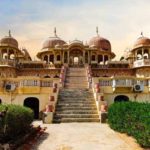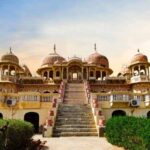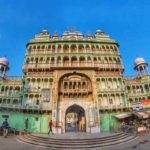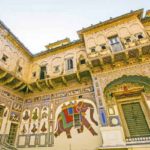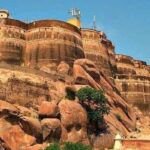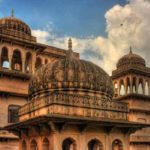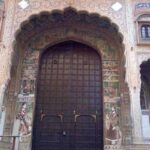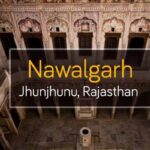Shekhawati Travel Guide is a region in the Thar Desert, the northern part of Rajasthan. This region is famous for its havelis which comprise of Sikar, Jhunjhunu, and Churu. Shekhawati gives a colourful display of Rajasthani culture. As the history entails, Marwari merchant constructed these grand and beautiful havelis.
One will be awestruck by such huge havelis (mansions) which are a home of beautiful art, architecture as well as the commendable fresco paintings. Shekhawati is also known as “Open Art Gallery” and it is because, the showcase of architecture can be witnessed in the havelis which are present out in the open. Those who want to experience the rich heritage of India, Shekhawati can be the best place. Shekhawati Travel Guide is not only home of haveli but it is home of step wells, chhatris and forts build by Shekhawati Rajput rulers and Marwar community. It is undoubtedly a paradise for art and architecture lovers.
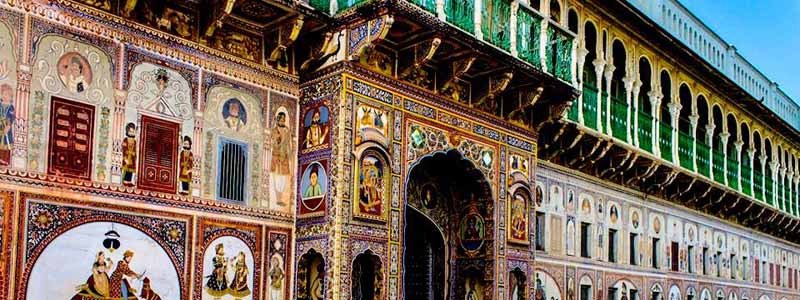
History of Shekhawati: a historical place of Rajasthan
The word ‘Shekhawati‘ originated from the ‘Garden of the Shekhas’. It comes from Rao Shekha who was the chief of a tribal community called Barwada. They used to rule in Amer which is currently known as Jaipur.
Rao always maintains a status of a quo and he was the first chieftain who signed a treaty with Amer that made him an independent ruler. Afterwards, the legacy of Shekhawati got linked with the Mughals, British East India Company and the state come under the British rule.
You can find a few strong pieces of evidence of Shekhawati in Marukantar Desha period of Ramayana. As we know that over the 16 mahajanapadas period to Buddha, we can find only two Janapadas like Avanti and Virata in Rajasthan.
Shekhawati was influenced by Avanti and later, it was occupied by Nandas of Magadha. According to some historians, Rajasthan, as well as Shekhawati Travel Guide, was obtained by Mauyas from Nandas. On the other part, during the ancient period, Shekhawati was divided into several janapadas and it was known as Matsya Kingdom.
Every Janapada was a free republic state and this system was developed by Aryan. After Gupta Dynasty, some parts of Shekhawati like, Jhunjhunu, Fatehpur, and Narhar were occupied by the Kaimkhanis, and later the entire Shekhawati region was occupied by Rajputs.
Rajasthan is a place of Rajputs and still, you can find some Rajput families in Rajasthan. It is true that they have lost their kingdom after India’s independence, but they have strong influences in Rajasthan. Shekhawati was founded and ruled by Shekhawat Rajputs, and Rao Shekha from Dhundhar established his independent kingdom with the capital at Amarsar.
After Rao Shekha, Rajasthan, as well as Shekhawati Travel Guide, was ruled by several rulers from the same dynasty as Rao Raimal, Rao Suja, and Rao Lunkaran. In the time of Rao Shekha, Shekhawati was divided into 33 thikanas which was known as Pargana. Each of them had their fort which was structured by mud and later, Rajputs developed some stone embedded forms in these Parganas as their head office. Even a few of them had their flag and emblems.

Architectural Style of Havelis in Shekhawati:
The word ‘fresco’ can be found in Michelangelo’s ‘The Creation of Adam’ and it is described the art of painting done by natural and wet plasters. If you want to explore some fresco arts then you must visit Shekhawati once because here you can find numerous havelis that designed with fresco paintings. Especially, you can find such havelis in Fatehpur, Nawalgarh, Jhunjhunu and Mandawa regions of Shekhawati.
Earlier, traders or Bania in Rajasthan used to earn huge loyalty from their business, but they did not invest such amounts for building their own havelis. Rajput kings were wealthy enough to establish some magnificent havelis in Shekhawati and they were structured some havelis with particular theme and motifs Rajasthan Budget Tours.
But, you can find some small mansions made by traders in Shekhawati Travel Guide and these havelis are painted with fresco painting. Ilay Cooper already mentioned such paintings in his books named “The Painted Towns of Shekhawati” and he has written that those unexplored havelis were built by the Bania or traders.
They used to build such small havelis to represent their social status. You can travel through some small villages in Shekhawati to explore such havelis built between 1830 -1930. But, you will get surprised to see the significant proofs of the time machine in these havelis.
Do you know that an aeroplane was painted on the Belgian glass during that time? Even, Lord Krishna and his gopikas were painted with some modern ornaments designed with lapis lazuli and gold. We know that such fresco images were developed by the imagination of the painters, but they have predicted the future through their artworks, which is quite surprising.
Structure of the havelis in Shekhawati share some common layouts and you can find deep influences of Mughal’s artworks in their structures. Most of the havelis have at least two floors and the upper floors of these havelis are designed as an open balcony, which was known as ‘chajja’.
Apart from that, you can find few rooms on the terrace of these havelis and the ground floor of these mansions are designed separately to make a uniform structure.
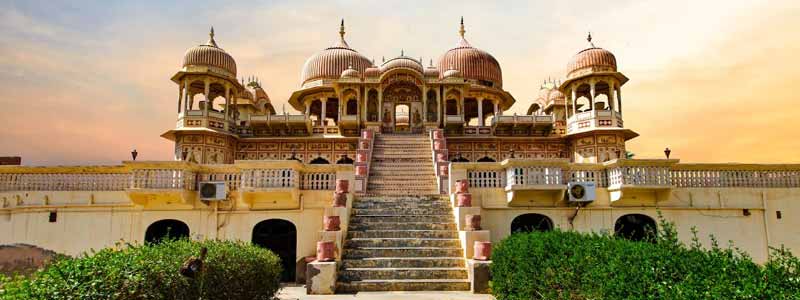
Places to see in Shekhawati
There are many towns to see in Shekhawati Travel Guide and roam around to witness the beauty of this painted land. Here we have listed the best places to visit in Shekhawati, the main points of attraction in the region are Alsisar, Mandawa, Dundlod, Fatehpur, Ramgarh, Bissau, Mahansar, Khandela, Jhujhunu, Sikar, Khetri, Nawalgarh, Mukundgarh, Bagar, Chirawa and many more…We also covers parts of Churu and other adjoining districts of Shekhawati region where the art and culture attraction points are relevant to the visitors traveling this area of Rajasthan.
Nawalgarh
Nawalgarh was a prosperous town in the Shekhawati region. Thakur Nawal Singh was the founder of this city, and from here itself, the city has derived its name. Thakur Nawal Singh is considered to be the son of Shardul Singh (most successful ruler of Shekhawati). There are a lot of havelis in Nawalgarh with some of them being the Aath Haveli, Murarka Haveli, Khedwal Bhawan, Bhagton ki Haveli, and Anandi Lal Poddar Haveli and these are renowned as the top visited places of Nawalgarh.
Attractive frescoes and mural paintings are breath-taking and actually showcase the talent of workmen who created it. Apart from this Ganga Mai is one famous attraction of Nawalgarh. This temple is dedicated to goddess Ganga. Beautifully carved structure and the astonishing interior are worth visiting. Upper dome (mandapa) is filled with a lot of beautiful paintings.
Sethani Ka Johara
Showcasing the bravery and valour of the wives of warriors, the Sethani Ka Johara has always taken the tourists back to the bygone era. Sethani ka Johara is a reservoir located west to Churu, Shekhawati Travel Guide. All the havelis in Shekhawati region were built in 18th century and early 20th century. This reservoir was built in 1899 by a widow of Bhagwan das Bagla. It was the finest Johara in the area containing sufficient water in it. This attractive Johara not only attracts humans but also a large number of birds. This peaceful place is perfect for spending your evening while you witness picturesque sunset. One can actually spot the reflection of architecture in the water.
Tal Chappar sanctuary
Located in the Churu district of Rajasthan and 250km from Jaipur, Rajasthan “Tal Chappar sanctuary” is one of the most popular tourist attractions of Shekhawati Travel Guide region. It is known for the exquisite birds such as the Blackbug and other variety of birds. The name of this Sanctuary was given after the name of Chhapar village. The whole sanctuary is covered with open grassland and scattered Acacia and Prosopis trees.
Migratory birds visit this sanctuary in the month of September, which includes birds like Montagu’s harrier, marsh harrier, pale harrier, imperial eagle, tawny eagle, short-toed eagle, sparrow hawk, Skylark, crested lark, ring drove, brown dove, blue jay, southern grey shrike, etc. There are two rest houses situated in the sanctuary. It is Perfect home for birds’ lovers. One can spot the desert fox and also the desert cat here. It has become a hotspot among wildlife lovers.
Khetri Mahal
Known as wind palace of Jhunjhunu, Khetri Mahal is proudly situated in the Khetri. Surprisingly this Mahal has no windows still it is known as a wind palace. You can actually have a soothing feeling while exploring this Mahal because of the wind flow. Most of the rooms are connected through arched portals. This Mahal was built in the year 1770. The terrace gives an absolutely breathtaking view of all the buildings of that region.
It was famous for its paintings and murals, now fragments of these paintings are kept in private chamber of Thakurs. Structure of the Khetri Mahal is unique than any other building of that region. One can spot the gigantic Badalgarh Fort from Khetri Mahal which was constructed in the early 16th century. A large portion of the Mahal is covered with pinkish plaster.
Mandawa
Mandawa is a beautiful town of Shekhawati Travel Guide region. It is situated 190km off to Jaipur which is capital of Rajasthan. This town is filled with fort and Havelis. It once functioned as a trade hotspot for the goods from China and the Middle East. There are references regarding the founder of Mandawa and Mandu Jat. This place was known as ‘Mandu ki Dhani’, ‘Mandu ka Bas’ or ‘Manduwas’ which changed to ‘Manduwa’, ‘Mandwa’ and finally to ‘Mandawa’.
Thakur Nawal Singh was the ruler of Nawalgarh as well as Mandawa and magnificent Mandawa fort was built by him in the middle of the town. This fort is presently serving as a heritage hotel. One can experience the era of Lord Krishna after entering in the fort as its gateway is adorned with paintings of Lord Krishna and his cows.
Dundlod
Dundlod is the town in Jhunjhunu district of Rajasthan. The town can be reached by road from Delhi, Bikaner and Jaipur. Dundlod is famous for its forts and havelis, which are decorated by richly fresco paintings. Dundlod fort is the massive Rajputana fort built by Keshari Singh in the year 1750 and later major additions were added by Sheo Singh in the 19th century. Beautiful Chhatri of Ram Dutt Goenka is also one of the major tourist attractions here which was built in the year 1888, the dome of chhatri has beautifully carved floral motifs.
War panorama of Mahabharata is described in the paintings of inner base. Apart from the Chhatri, there is Satyanarayan Temple built by the Goenka Family. Dundlod fort can also be called as the most perfect mixture of Rajput as well as Mughal art. The Diwan-e-Khas (Hall of private audience) is decorated with fine antiques and an impressive library, the Zenana quarters are on the 1st floor, featuring furniture and exquisite décor.
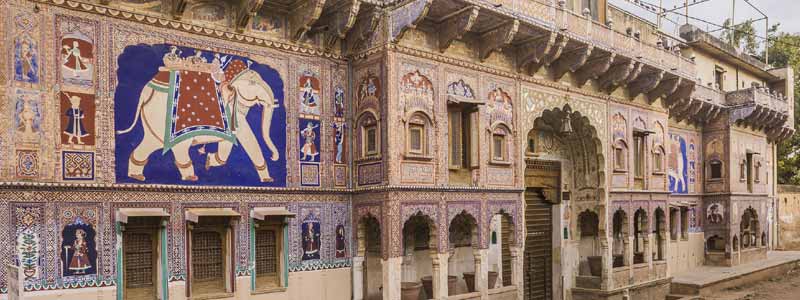
Best Time to Visit Shekhawati
You can visit Shekhawati at any time, but it is better to visit during winter. The temperature during winter remains comfortable and this time is ideal for sightseeing. The best time to visit Shekhawati is from October to December.
Else, you can plan your trip during March to explore Shekhawati Travel Guide in moderate temperatures. The temperature during winter (November to February) in Shekhawati ranges 5°C to 28°C. But, you can find extreme heat during summer and the temperature during summer can reach up to 45°C.
Apart from that, you can visit Shekhawati during monsoon (July-September), and you will feel the cool breeze with a pleasant climate in Shekhawati. Check the Rajasthan Tour Packages of Colorful Indian Holidays to plan your heritage trips to the beautiful places in the state including Shekhawati.
How to Reach Shekhawati?
By Air : Saganer Airport in Jaipur is the nearest airport to reach Shekhawati by Air. You can take a bus or taxi to cover the rest of journey from airport to Shekhawati that is covered roughly in half an hour.
By Rail : Jhunjhunu is the nearest city having railway station to reach Shekhawati by train. There are regular trains to Jhunjhunu and Jaipur from rest of the country.
By Road : Jaipur is at the distance of 8 km from Shekhawati Travel Guide that is covered by bus or taxi. There are regular buses from other cities of Rajasthan to reach here. You can also reach by your own car.

